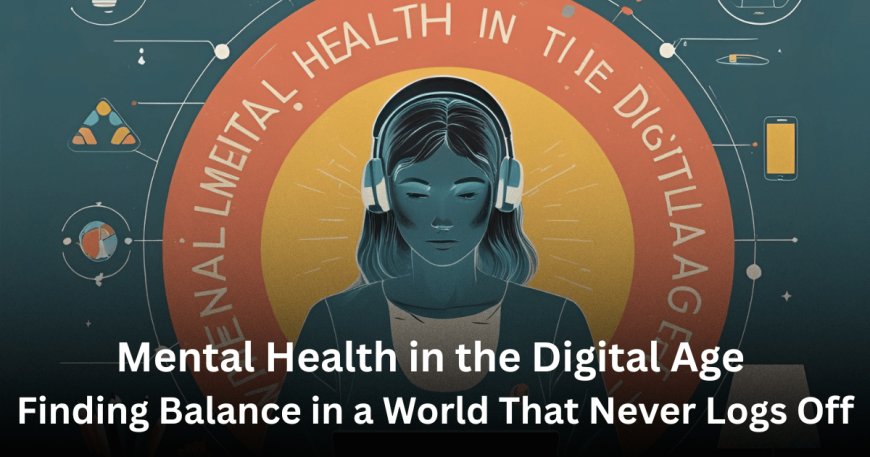Mental Health in the Digital Age: Finding Balance in a World That Never Logs Off
Mental Health in the Digital Age: Finding Balance in a World That Never Logs Off

In today’s hyper-connected world, the digital age has transformed how we live, work, and interact. Smartphones, social media, and constant access to information have made life more convenient but also introduced new challenges to mental health. The pressure to stay online, the barrage of notifications, and the curated perfection of social media feeds can lead to anxiety, stress, and a sense of inadequacy. Yet, technology also offers tools to support well-being, from meditation apps to online therapy. This blog explores the dual impact of the digital age on mental health and provides practical strategies to maintain balance in a world that never logs off.
The Double-Edged Sword of Technology
The digital age has revolutionized communication and access to information. Social media platforms like X connect people across the globe, fostering communities and sharing knowledge at unprecedented speeds. However, this constant connectivity comes at a cost. Studies show that excessive screen time correlates with increased anxiety, depression, and sleep disturbances. A 2019 study published in The Lancet Child & Adolescent Health found that adolescents spending more than three hours daily on social media were at higher risk for mental health issues, including internalizing problems like anxiety and low self-esteem.
The "always-on" culture fuels a fear of missing out (FOMO), where individuals feel compelled to stay updated on every post, trend, or news cycle. This can lead to compulsive checking of devices, disrupting focus, and increasing stress. Moreover, the curated nature of online content, where people showcase highlight reels of their lives, can foster comparison, eroding self-worth. On X, for instance, viral posts often amplify idealized lifestyles, which can make users feel their own lives don’t measure up.
Yet, technology isn’t inherently harmful. Apps like Headspace and Calm offer guided meditation, while platforms like BetterHelp provide access to licensed therapists online. Wearable devices track sleep and activity, helping users make data-driven choices for their health. The key is to harness technology’s benefits while mitigating its downsides.
The Impact of Digital Overload
Digital overload occurs when the volume of information and interactions exceeds our capacity to process them. Notifications, emails, and endless scrolling can overwhelm the brain, leading to cognitive fatigue. According to a 2023 report by the American Psychological Association, 43% of adults reported feeling more stressed due to constant digital notifications. This overload disrupts attention spans, with studies suggesting that frequent smartphone use reduces the ability to focus on tasks for extended periods.
Social media algorithms, designed to maximize engagement, often prioritize emotionally charged content, which can heighten stress or anxiety. On platforms like X, trending topics can shift rapidly, pulling users into heated debates or polarizing discussions. This can trigger emotional reactivity, especially when algorithms amplify outrage-driven content. Additionally, excessive screen time, particularly before bed, disrupts melatonin production, leading to poor sleep quality, a critical factor in mental health.
Strategies for Staying Balanced
Maintaining mental health in the digital age requires intentional strategies to manage technology use and prioritize well-being. Here are practical steps to stay balanced:
1. Set Boundaries with Technology
Establishing clear boundaries is essential to prevent digital overload. Consider implementing a "digital detox" by designating tech-free hours, such as during meals or before bedtime. Use features like "Do Not Disturb" modes or app timers to limit notifications. For example, iOS and Android devices allow users to set daily limits for specific apps, reducing mindless scrolling.
Create tech-free zones, like the bedroom, to improve sleep hygiene. A 2021 study in Sleep Medicine found that avoiding screens an hour before bed improved sleep quality by 30%. Replace evening screen time with activities like reading a physical book or journaling to unwind.
2. Curate Your Digital Environment
Be intentional about the content you consume. On platforms like X, mute or unfollow accounts that trigger stress or negativity. Follow creators who share positive, educational, or inspiring content. For instance, accounts focused on mental health advocacy or mindfulness practices can provide daily reminders to prioritize well-being.
Use tools to filter out harmful content. Most social media platforms allow users to block keywords or hashtags associated with triggering topics. Curating your feed to align with your values and interests can make digital spaces feel more supportive than draining.
3. Practice Mindful Engagement
Mindfulness can transform how you interact with technology. Before checking your phone, pause to ask, “Why am I doing this?” This simple question can prevent compulsive use. Engage with intention, set a purpose for your time online, whether it’s connecting with friends, learning something new, or sharing a meaningful post.
Try the "5-5-5" rule: for every hour online, spend five minutes focusing on your breath, five minutes stretching, and five minutes reflecting on something you’re grateful for. This practice grounds you and counteracts the mental clutter of digital overstimulation.
4. Leverage Technology for Mental Health
Technology offers powerful tools to support mental well-being. Meditation apps like Insight Timer provide free guided sessions, while mood-tracking apps like Daylio help monitor emotional patterns. Online communities, such as mental health support groups on X, offer spaces to share experiences and find solidarity.
Virtual therapy has become a game-changer, especially for those with limited access to in-person care. Platforms like Talkspace connect users with therapists via text, voice, or video, making support more accessible. Explore these tools to find what fits your needs, but use them mindfully to avoid over-reliance.
5. Prioritize Offline Connections
While digital connections are valuable, face-to-face interactions are crucial for mental health. A 2022 study in the Journal of Social and Personal Relationships found that in-person socializing boosts mood more than online interactions. Schedule regular catch-ups with friends or family, and engage in activities like group hikes or game nights to foster deeper bonds.
If in-person meetups aren’t feasible, use video calls to maintain closeness. Unlike text-based communication, video chats preserve nonverbal cues, making interactions feel more authentic. Balance online and offline relationships to create a holistic support network.
6. Develop a Healthy Information Diet
Just as you choose nutritious food, be selective about the information you consume. Limit exposure to news or posts that provoke anxiety. Set specific times to check updates once in the morning and once in the evening, for example, to avoid constant news cycles. Use trusted sources for information and avoid sensationalized content that thrives on clicks.
On X, follow accounts that provide factual, balanced perspectives rather than those that amplify drama. If a topic feels overwhelming, take a break and redirect your focus to something calming, like a hobby or creative outlet.
7. Build Digital Literacy
Understanding how digital platforms work can empower you to use them wisely. Learn about algorithms and how they influence what you see. For instance, engaging with positive content on X can train the algorithm to show more of it. Recognize when you’re being pulled into a rabbit hole of polarizing posts and consciously disengage.
Educate yourself on privacy settings to control who sees your data and how it’s used. This knowledge reduces the sense of vulnerability that can accompany online participation, fostering a greater sense of control.
The Role of Self-Compassion
Staying balanced in the digital age requires self-compassion. It’s easy to feel guilty for spending too much time online or comparing yourself to others. Instead of self-criticism, acknowledge that navigating this hyper-connected world is challenging for everyone. Celebrate small wins, like sticking to a screen-time limit or completing a mindfulness exercise.
Self-compassion also means forgiving yourself for digital slip-ups. If you find yourself doomscrolling, gently redirect your attention without judgment. Over time, these small adjustments build resilience and healthier habits.
The Future of Mental Health in the Digital Age
As technology evolves, so will its impact on mental health. Emerging tools like AI-driven mental health chatbots or virtual reality therapy hold promise for personalized support. However, these advancements must be paired with education on responsible use to avoid dependency. Governments and tech companies are also beginning to address digital well-being, with initiatives like screen-time guidelines and content moderation policies.
Ultimately, the responsibility lies with individuals to set boundaries and prioritize mental health. By combining self-awareness, intentional habits, and the right tools, it’s possible to thrive in the digital age without sacrificing well-being.









































